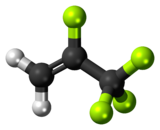
Back 3،3،3،2-رباعي فلورو البروبين Arabic ۲٬۳٬۳٬۳-تترافلوئوروپروپیلن AZB 2,3,3,3-Tetrafluoropropè Catalan 2,3,3,3-tetrafluorpropen Czech 2,3,3,3-Tetrafluorpropen German ۲٬۳٬۳٬۳-تترافلوئوروپروپیلن Persian 2,3,3,3-Tétrafluoropropène French 2,3,3,3-Tetrafluoropropene Italian 2,3,3,3-tetrafluorpropeen Dutch 2,3,3,3-Tetrafluoropropen Serbo-Croatian

| |

| |
| Names | |
|---|---|
| Preferred IUPAC name
2,3,3,3-Tetrafluoroprop-1-ene | |
| Other names
HFO-1234yf; R1234yf; R-1234yf; 2,3,3,3-Tetrafluoropropylene
| |
| Identifiers | |
3D model (JSmol)
|
|
| ChemSpider | |
| ECHA InfoCard | 100.104.879 |
| EC Number |
|
PubChem CID
|
|
| UNII | |
| UN number | 3161 |
CompTox Dashboard (EPA)
|
|
| |
| |
| Properties | |
| C3H2F4 | |
| Molar mass | 114 g/mol |
| Appearance | Colorless gas |
| Density | 1.1 g/cm3 at 25 °C (liquid); 4 (gas, relative, air is 1) |
| Boiling point | −30 °C (−22 °F; 243 K) |
| 198.2 mg/L at 24 °C, 92/69/EEC, A.6 | |
| log P | 2.15, n-octanol/water, 92/69/EEC, A.8 |
| Vapor pressure | 6,067 hPa at 21.1 °C; 14,203 hPa at 54.4 °C |
| Hazards | |
| GHS labelling: | |
 
| |
| H220, H280 | |
| P210, P260, P281, P308+P313, P410+P403 | |
| 405 °C (761 °F; 678 K) | |
| Explosive limits | 6.2% vol.; 12.3% vol. |
Except where otherwise noted, data are given for materials in their standard state (at 25 °C [77 °F], 100 kPa).
| |
2,3,3,3-Tetrafluoropropene, HFO-1234yf, is a hydrofluoroolefin (HFO) with molecular formula CH2=CFCF3. Its primary application is as a refrigerant with low global warming potential (GWP).[1][2]
As a refrigerant, it is designated R-1234yf[1] and marketed under the names Opteon YF by Chemours and as Solstice YF by Honeywell.[3] R-1234yf is also a component of zeotropic refrigerant blend R-454B.
HFO-1234yf has a GWP less than carbon dioxide,[4][2] itself 1,430 times less potent than R-134a.[5] For this reason, 2,3,3,3‑tetrafluoropropene is the pre-eminent replacement for R-134a in vehicular air conditioners. As of 2022, 90% of new U.S. vehicles are estimated to use HFO-1234yf.[6] Unlike previous vehicular refrigerants, 2,3,3,3‑tetrafluoropropene is flammable, but does not increase fire risk in internal combustion engines.
One drawback is it breaks down into short-chain perfluorinated carboxylic acids (PFCAs), which are persistent organic pollutants.[7]
- ^ a b Sciance, Fred (October 29, 2013). "The Transition from HFC- 134a to a Low -GWP Refrigerant in Mobile Air Conditioners HFO -1234yf" (PDF). General Motors Public Policy Center. Retrieved 1 August 2018.
- ^ a b Cite error: The named reference
CP2014was invoked but never defined (see the help page). - ^ "Honeywell and Chemours Announce New Manufacturing Plants for HFO 1234yf". Aspen Refrigerants. June 12, 2017. Archived from the original on 4 August 2020. Retrieved 26 July 2018.
- ^ Cite error: The named reference
WMOwas invoked but never defined (see the help page). - ^ Cite error: The named reference
AR4was invoked but never defined (see the help page). - ^ "StackPath". www.vehicleservicepros.com. 23 March 2022. Retrieved 2022-05-28.
- ^ Wang, Ziyuan; Wang, Yuhang; Li, Jianfeng; Henne, Stephan; Zhang, Boya; Hu, Jianxin; Zhang, Jianbo (30 January 2018). "Impacts of the Degradation of 2,3,3,3-Tetrafluoropropene into Trifluoroacetic Acid from Its Application in Automobile Air Conditioners in China, the United States, and Europe". Environmental Science & Technology. 52 (5): 2819–2826. Bibcode:2018EnST...52.2819W. doi:10.1021/acs.est.7b05960. PMID 29381347.
© MMXXIII Rich X Search. We shall prevail. All rights reserved. Rich X Search